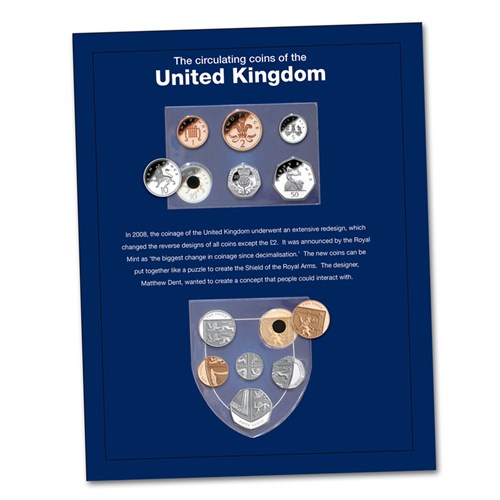Posts Tagged ‘5p’
Could the 5p coin in your change be worth over £60?
The Kew Gardens 50p, Commonwealth Games Northern Ireland £2 and ANY of the A-Z 10ps are likely to be on your collecting wish-list, but have you ever considered that some of the 5p coins in your change might be worth holding on to?
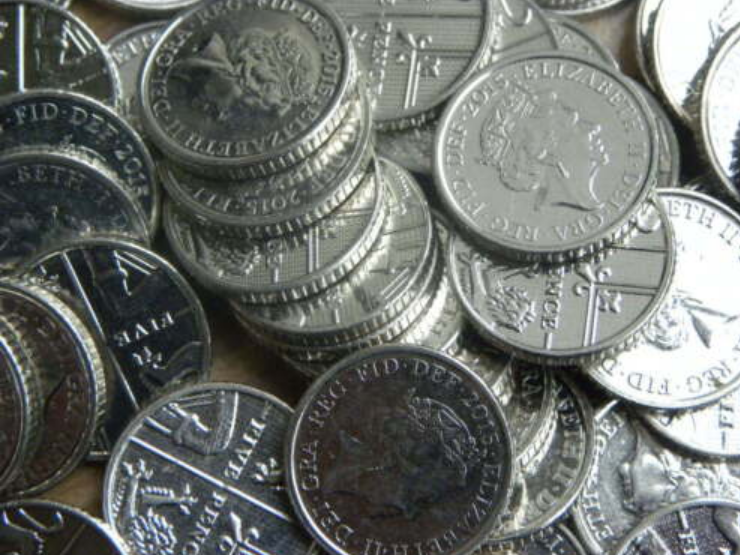
Credit: eBay
The smallest of our UK coinage – weighing in at just 3.25g, with a diameter of only 18mm – is often overlooked when it comes to collecting. But what if I told you some of them have been known to sell for over £60 on the secondary market?!
What are the rarest 5p coins?
1977 5p
Unlike the Kew Gardens 50p (which has a mintage of just 210,000), 5p coins are often minted in the tens of millions, or even billions! However, the 1977 5p is the rarest with a mintage figure of 24,308,000. Compare this to the 1990 5p which had a circulating mintage of 1,634,976,005 and you’ll see why it’s pretty rare!

Credit: The Royal Mint
2008 First 5p with the shield design
In 2008, 40 years after the first decimal coins appeared in circulation, our UK definitive coins had a face lift, with brand new designs being released.
A competition was held, with people submitting their designs for the six key coin denominations, leaving out the £2 coin. Over 4,000 designs were submitted, but graphic designer Matthew Dent won the competition with his heraldic design of six coins, with the 1p-50p coins aligning to form the Royal Shield – shown as a complete design on the £1 coin.
As the first year definitive coins were issued with the shield design, 2008 dated 5ps are somewhat coveted by collectors. Although you’re unlikely to see the 2008 or 1977 5p coins fetch above face value, they are certainly interesting ones to collect.
But the real interest comes if you’re lucky enough to find the error 5p coins…
Spot These 5p Error Coins
Inverted effigy 2008 5p
Another reason to keep an eye out for a 2008 dated 5p coins is that an unknown number were released into circulation featuring the Queen’s head on the obverse upside down. These error coins are extremely rare and some have been listed on the secondary market for more than £60!
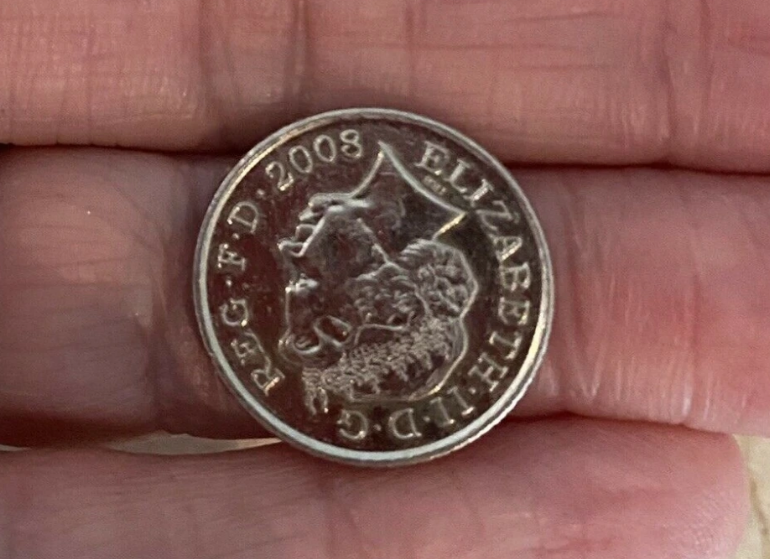
Credit: eBay
‘Struck twice’ 1979 5p ‘Error’
On this larger specification ‘New Five Pence’ which is no longer in circulation, but a suspected error was found, where it appeared to have been struck twice on the same side in error. This would mean both the Queen’s head from the obverse and the design on the obverse would be merged together on the same side of the coin.
This ‘error’ hasn’t been confirmed as genuine by The Royal Mint and with closer inspection, it looks as though the reverse design is from a 2p coin – suggesting it might have been tampered with after it was struck.
However one collector sold theirs for £73 on eBay, meaning it always worth looking out for any unusual coins you might have lying around! Just remember, you should always get your error coins confirmed by the mint to prove they are genuine.
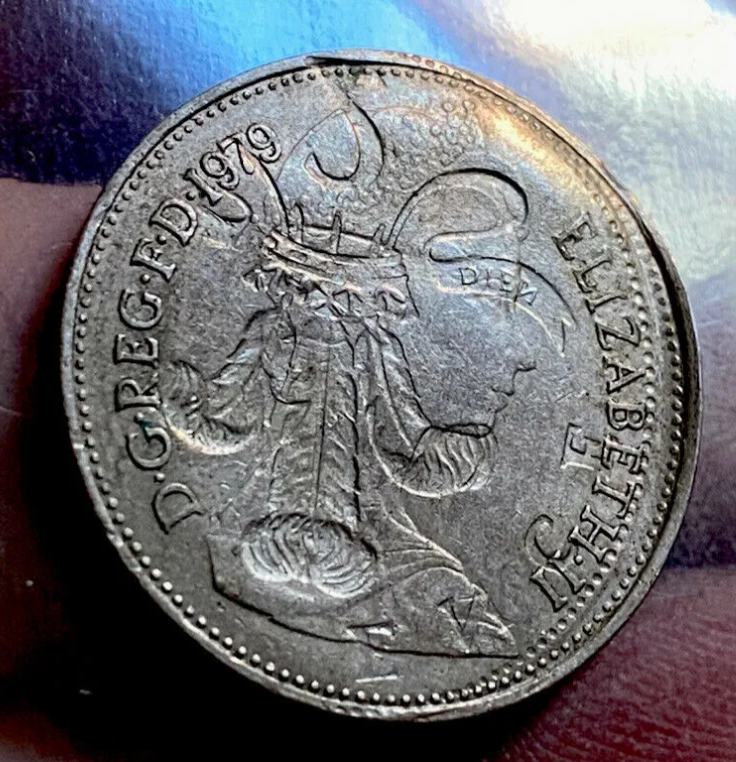
Credit: eBay
The 5p Coins Not Intended for Circulation
From time to time, coins that were never intended for circulation find their way into our change.
They might have been issued in collector sets, broken open and accidentally spent before finding their way into your pocket!
There are two dates to look out for when it comes to 5p coin that shouldn’t be in your change – 1993 and 2018.
Prior to 1990, the 5p coins were issued in the larger specification and so these ones should also no longer be found in your change.
Have you come across any rare or error 5p coins in your change? Let us know in the comments below!
Complete the shield with the Royal Arms Shield Collector Card!
Designed to fit neatly into your Change Checker Album, this Collector’s card allows you to assemble the Royal Arms Shield by simply using your loose change.
Click here to secure yours and start your shield collection today >>
Complete the shield!
It’s been more than 10 years since Matthew Dent redesigned the UK’s definitive coins to create the Royal Shield of Arms design, but there are still some people who don’t actually realise that these coins can be pieced together to complete the shield.
Dent’s design was chosen by The Royal Mint Advisory Committee following a public competition which saw over 4,000 designs submitted. “I felt that the solution to The Royal Mint’s brief lay in a united design,” he explained. “United in terms of theme, execution and coverage over the surface of the coins.”
Using all the coins from the 1p to the 50p and fitting them together like a jig-saw, the complete shield is revealed, as seen on the £1 coin design issued from 2008 until 2015.

Of course, the old round pound has now been replaced by the 12 sided £1, featuring the Nation’s of the Crown design. But, the definitive 1p, 2p, 5p, 10p, 20p and 50p shield coins can still be found in your change, meaning the Royal Shield can still be collected and completed.
In fact, I bet if you were to check the change in your pocket right now, you’d be surprised by how much of the shield you’ll already be able to piece together!
So why not try collecting the shield, and if you’d like to give yourself even more of a challenge, how about collecting the whole shield for each year, starting with the coins issued in 2008.
As we’ve now come to the 10th anniversary of these coins, perhaps there will be a re-design on the horizon? If the reverse of our definitive coins were redesigned, what design would you like to see on the new coins?
Complete the shield with the Royal Arms Shield Collector Card!
Designed to fit neatly into your Change Checker Album, this Collector’s card allows you to assemble the Royal Arms Shield by simply using your loose change.
Click here to secure yours and start your shield collection today >>
50 years since the most important moment in British numismatic history…
2018 marks the 50th anniversary of arguably the most important moment in British numismatic history – the first coins issued for decimalisation.
In 1968, the British public would have found 5p and 10p coins in their change for the very first time, issued as part of Britain’s conversion to a system of decimal currency.

1968 5p and 10p coins
The coins bore new heraldic designs, but were exactly the same size and value as shillings and florins, which meant the changeover process should have been a smooth transition. However, after generations of pounds, shillings and pence, the Decimal Currency Board still needed to reassure suspicious Britons to go decimal – a case which had actually been argued as long ago as 1696 by Sir Christopher Wren.

Advert from the Decimal Currency Board. Credit: Daily Mail
It was the 1960 report by the Association of British Chambers of Commerce and the British Association for the Advancement of Science which finally set into action a currency based upon simple multiples, a system already adopted by a number of Commonwealth countries including Australia, New Zealand and South Africa.
A massive number of coins were required for the changeover, forcing The Royal Mint to move location from Tower Hill to its new production facility in Llantrisant, South Wales, where the first of almost six billion coins required for decimalisation went into production.

The Royal Mint at Tower Hill, London. Credit: The Royal Mint museum
It was then on the 23rd April 1968 that the new 5p and 10p coins went into circulation, operating as legal tender up to the sum of £5, with mintage figures of 98,868,250 and 336,143,250 respectively.
The humble 5p featured the Christopher Ironside reverse design until 2008 and has since featured Matthew Dent’s reverse design, following a public competition held by The Royal Mint. On the 27th June 1990, a reduced size version of the coin was introduced and the older, larger coins were withdrawn on the 31st December 1990, although the design remained unchanged.
Similarly, the 10p coin also featured Christopher Ironside’s reverse design up until 2008 when this was replaced by Matthew Dent’s. However, the 10p remained a larger coin until the 30th September 1992, when the reduced size version was introduced, with the larger coin being removed from circulation a year later.
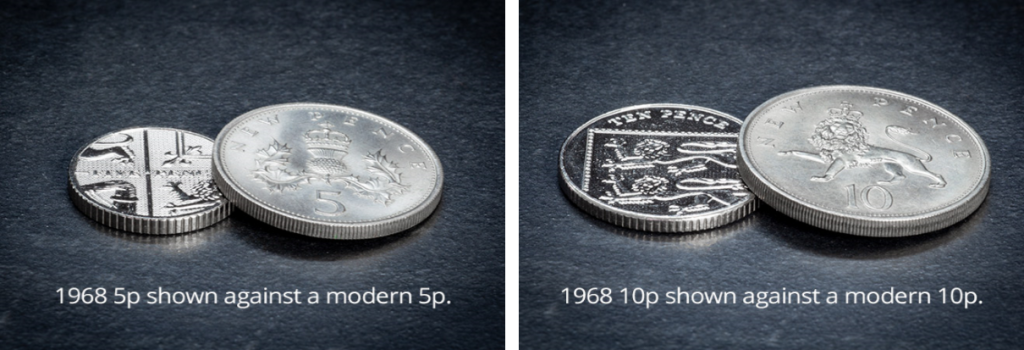
As we seem to move ever closer towards a cashless society, the questions lingers as to how long these decimalised coins will remain a necessity… However, this year’s release of 26 brand new A-Z of Great Britain 10p coin designs just goes to show that the demand for the smaller denomination coins is still there. In fact, these little coins have become incredibly sought-after and have dominated news stories and conversations amongst collectors, with everyone wanting to get their hands on the elusive coins!
Although the nation seemed reluctant to accept these decimal coins back in 1968, I think it’s fair to say that they have now become a much loved part of British coinage and as we celebrate the 50th anniversary of the first decimalised coins, we can look back with fondness for the 5p and 10p coins.
Own the very first coins issued for decimalisation!
The First Decimalised Coins include the original 5p and 10p coins from their first year of issue, 1968.
Order yours today to mark the 50th anniversary of the introduction of these significant coins >>



